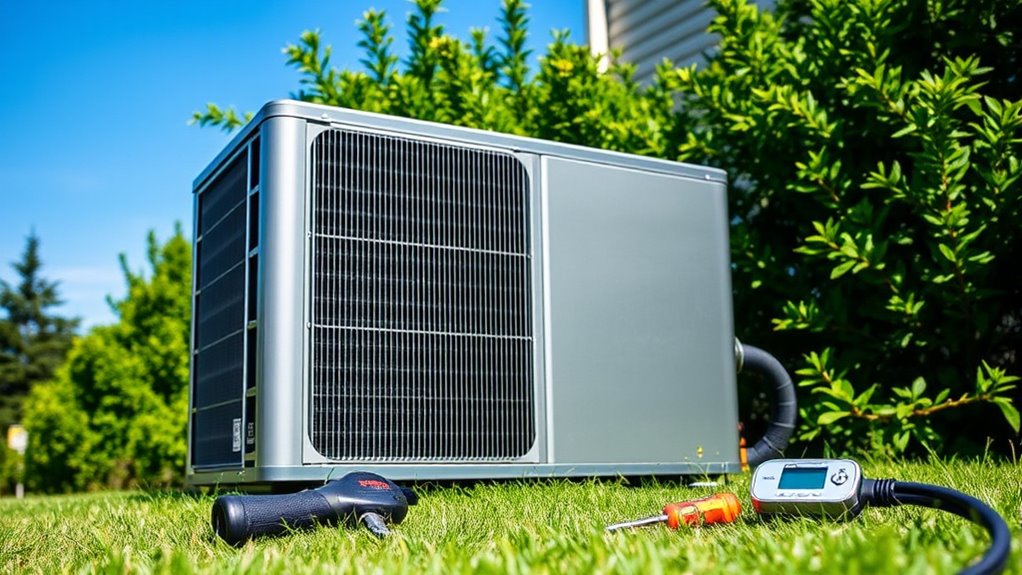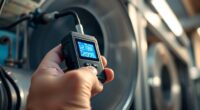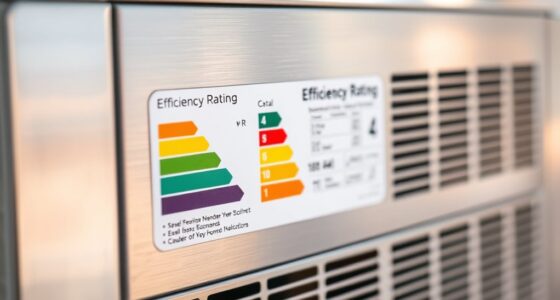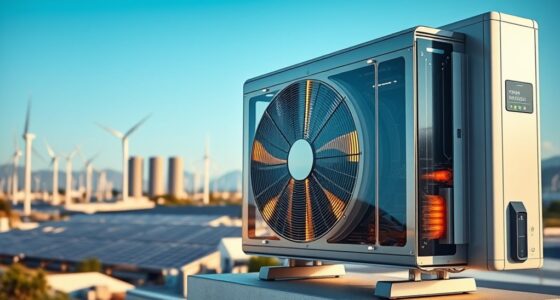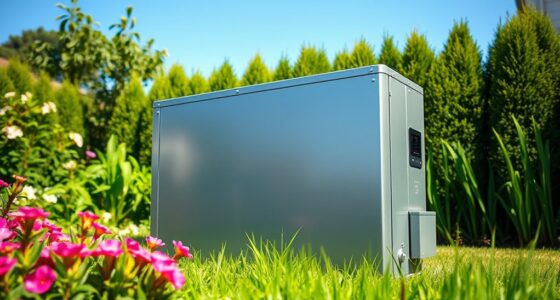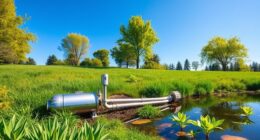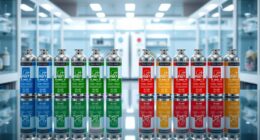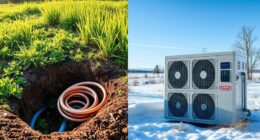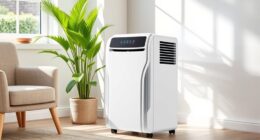To boost your existing heat pump’s efficiency, focus on sealing air leaks and adding insulation to reduce heat transfer. Upgrade to variable-speed fans for better airflow control, and install smart thermostats for precise temperature management. Improving ductwork and adding humidity controls can also help. Consider upgrading to a cold-climate model or supplemental heating. These common upgrades can save energy and money—continue exploring to learn even more ways to optimize your system.
Key Takeaways
- Upgrade to higher efficiency heat pump models with improved HSPF2 and SEER2 ratings.
- Seal and insulate ductwork to reduce leaks and improve airflow efficiency.
- Install programmable or smart thermostats for precise temperature and system management.
- Perform regular refrigerant charge checks and system diagnostics to maintain optimal performance.
- Add or improve air sealing around doors, windows, and duct penetrations to minimize heat loss.
Improving Home Insulation and Sealing Air Leaks
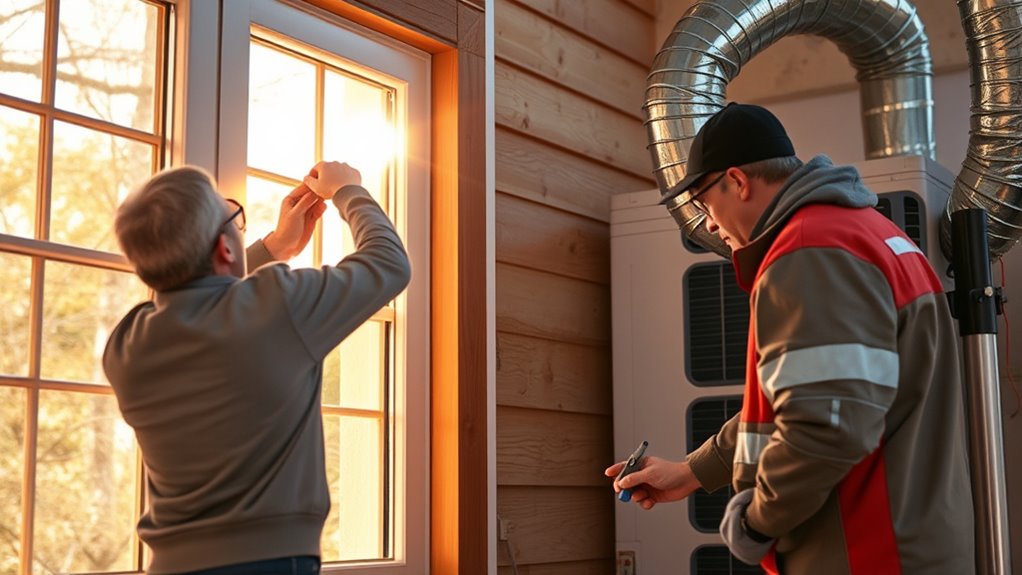
Improving your home’s insulation and sealing air leaks can substantially boost your heat pump’s efficiency. Proper insulation reduces heat transfer, helping maintain consistent indoor temperatures and lowering your energy bills. Sealing gaps around doors, windows, and ductwork enhances air tightness, preventing unwanted air leaks that cause heat loss. Weatherstripping and caulking are cost-effective methods to improve airtightness, reducing air leakage by up to 25%. Adding insulation to attics, walls, and floors minimizes heat transfer, decreasing your heat pump’s workload. An energy audit can identify the most critical leaks and insulation gaps, guiding targeted improvements. Additionally, using eco-friendly materials like sustainable insulation supports environmentally conscious upgrades. By focusing on insulation and sealing, you improve your home’s overall energy efficiency, making your heat pump operate more effectively and saving you money in the long run.
Upgrading to Variable-Speed Fans and Blowers
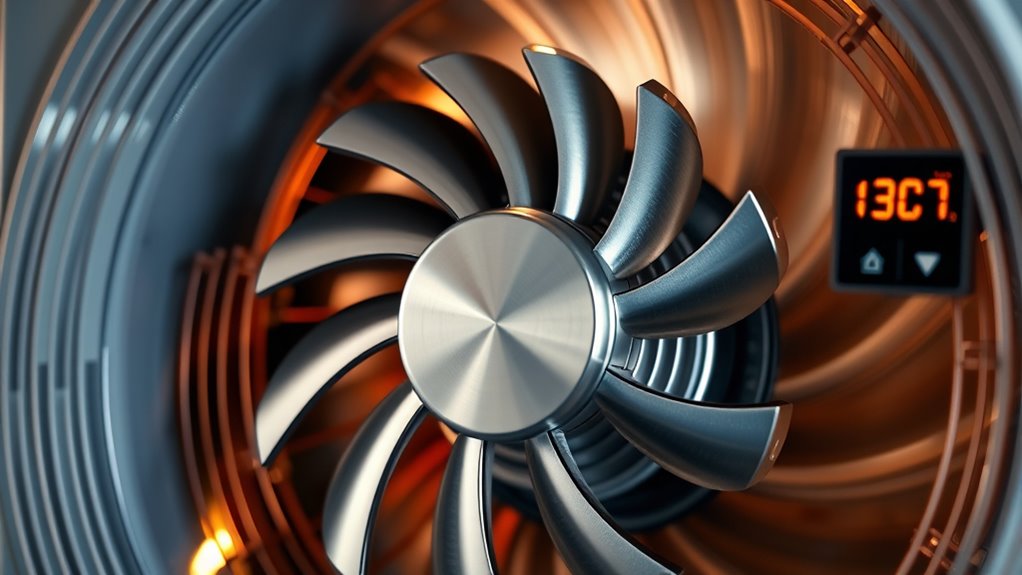
Upgrading to variable-speed fans and blowers allows your heat pump to operate more efficiently by continuously adjusting airflow to match your home’s heating and cooling needs. This system upgrade leads to smoother temperature control, better humidity management, and improved indoor air quality. With variable-speed fans, your heat pump can run at lower speeds longer, reducing energy consumption and increasing energy efficiency. You’ll also notice a significant noise reduction since these fans operate more quietly than single or dual-speed models. Additionally, the consistent airflow helps extend the lifespan of your system. Enhanced airflow control can further optimize system performance and energy savings. Modern variable-speed systems often feature advanced motor technology, which contributes to their improved performance and reliability. Utilizing smart system integration can also maximize efficiency by allowing remote adjustments and real-time monitoring. Incorporating variable-speed fan technology can provide even greater control over airflow and energy use.
Enhancing Thermostatic Controls for Better Regulation
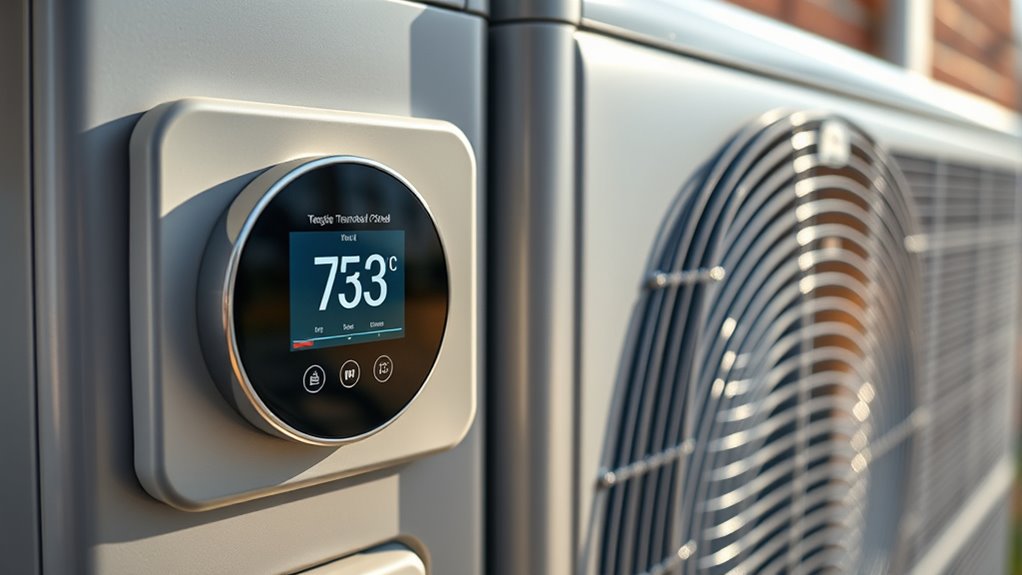
Enhancing your thermostatic controls can considerably boost your heat pump’s efficiency and comfort. Upgrading to programmable thermostats with Wi-Fi lets you set precise schedules and control your system remotely, preventing unnecessary operation. Modern thermostats with humidity sensors help maintain ideal indoor moisture levels, reducing strain on the heat pump. Adaptive learning thermostats analyze occupancy patterns and automatically adjust settings for ideal performance. Regular calibration ensures your controls stay accurate, while firmware updates keep features current and reliable. Consider the following benefits:
| Feature | Benefit | Impact |
|---|---|---|
| Programmable thermostats | Precise scheduling, energy savings | Up to 15% reduction in bills |
| Humidity sensors | Better comfort, reduced workload | Longer system lifespan |
| Adaptive learning | Automated optimization | Increased efficiency |
| Calibration | Accurate temperature control | Consistent comfort |
| Firmware updates | Enhanced functionality and security | Long-term savings |
Replacing or Upgrading Ductwork for Improved Airflow

Replacing or upgrading your ductwork is an essential step toward maximizing your heat pump’s efficiency. Poorly maintained or damaged duct systems can cause up to 25% of conditioned air to be lost before reaching your living spaces. Properly sized and insulated ducts improve airflow and can boost heating and cooling performance by 10-20%. Sealing air leaks in ductwork reduces energy waste and prevents heat transfer, enhancing overall energy efficiency. Regular maintenance, including inspection and sealing, keeps your system operating smoothly. Consider these key upgrades:
- Seal air leaks to prevent energy loss
- Insulate ducts to maintain temperature control
- Replace damaged or poorly designed duct sections for better airflow
- Airflow management plays a critical role in maintaining system efficiency.
Ensuring that your ductwork is free of obstructions and properly connected helps prevent air leakage, which is essential for optimal system performance. Additionally, implementing proper communication between system components can further enhance performance and energy savings. Proper duct design and layout can significantly influence the effectiveness of your heat pump system. According to the Beauty – Hours Today List, many retail locations have extended hours, making it easier to schedule maintenance or upgrades at your convenience. These improvements help your heat pump work more efficiently, saving you money and increasing comfort.
Installing Supplemental Heating and Cooling Options

Adding supplemental heating options gives you greater control over indoor temperatures, especially during extreme cold. Properly sized backup systems can reduce energy costs and prevent over-reliance on your heat pump. Integrating smart controls and hybrid systems helps optimize efficiency and maintain consistent comfort year-round.
Enhancing Temperature Control Flexibility
To improve temperature control flexibility with heat pumps, installing supplemental heating and cooling options is essential. These upgrades help maintain consistent comfort during extreme weather and optimize efficiency. Hybrid systems that switch automatically between heat pump and backup heat sources ensure reliable temperature control year-round. Proper zone control allows you to target specific areas, reducing energy waste. Regular system diagnostics keep supplemental heating and cooling components operating effectively, extending their lifespan. You can also consider system integration to streamline operation and enhance overall performance. Additionally, implementing automation technology can further optimize system responsiveness and energy use. Consider these efficiency upgrades:
- Adding auxiliary heating like electric resistance coils or gas furnaces for cold snaps
- Installing ductless mini-splits for zone-specific cooling
- Integrating hybrid systems for smarter operation and energy savings
- Upgrading thermostats with smart controls to enhance system responsiveness and user convenience
Implementing energy management strategies can further optimize overall system performance and reduce operational costs.
These improvements offer enhanced temperature control, increased comfort, and better system performance.
Integrating Backup Heating Systems
Integrating backup heating systems into your heat pump setup guarantees reliable warmth during the coldest days when the heat pump alone may struggle to maintain comfort. Installing electric resistance, gas, or propane backup heaters guarantees you stay warm when outdoor temperatures drop and system efficiency declines. Proper system integration allows your controls to activate auxiliary heat only when necessary, reducing energy use and improving overall system efficiency. Upgrading to modern, variable-speed heat pumps with advanced defrost and dehumidification features enhances performance alongside backup options. Regular maintenance of your backup system ensures safety, efficiency, and longevity, especially in colder climates. By thoughtfully combining backup heating with your heat pump, you optimize system performance, achieve energy savings, and ensure consistent comfort year-round.
Optimizing Refrigerant Charge and System Tuning
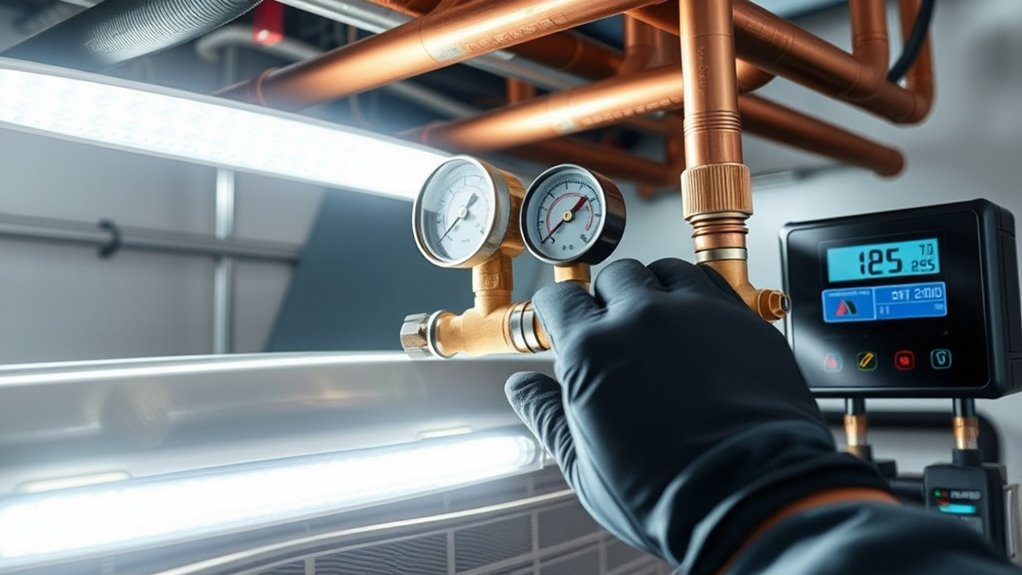
Ensuring the refrigerant charge is correct is essential for peak efficiency, as overcharging or undercharging can cut performance by up to 15%. Regular system diagnostics, including pressure and temperature checks, help identify issues early and keep your heat pump running smoothly. Proper maintenance and tuning prevent strain on the compressor, extend system life, and save you energy costs. Additionally, understanding the Mother’s Legacy and Tribute can motivate you to prioritize regular maintenance, ensuring your system honors its optimal performance just as a tribute honors a loved one. Recognizing the Foundations of fatherhood through shared responsibility and care can inspire diligent upkeep of your system, reflecting the importance of nurturing and support. Incorporating self-monitoring techniques, such as using smart thermostats or diagnostic tools, further enhances system reliability and efficiency. Staying informed about industry trends, including advancements in Honda Tuning and other automotive technologies, can help you stay ahead of new innovations that improve performance and energy savings.
Proper Charge Verification
How do you verify that a heat pump’s refrigerant charge is correct? Proper charge verification ensures the refrigerant level matches manufacturer specs, which is essential for optimal system tuning and performance. Overcharged or undercharged units can waste energy, reduce capacity, and cause early component wear. To accurately assess the refrigerant charge, you should:
- Use electronic leak detectors to identify leaks and confirm system integrity
- Measure subcooling and superheat to evaluate refrigerant levels
- Perform system tuning adjustments based on these measurements
- Conduct regular maintenance to sustain system efficiency and prevent issues
- Consult manufacturer guidelines and industry standards to ensure accurate procedures
- Regularly reviewing system performance data can help detect subtle inefficiencies and prevent long-term issues.
- Employing diagnostic tools can further enhance the accuracy of refrigerant charge assessments.
- Additionally, understanding the fundamentals of sound design can aid in diagnosing system anomalies through noise patterns, ensuring the refrigerant charge remains optimal.
These steps help optimize energy efficiency and ensure the system operates at peak performance. Regular verification, especially after repairs or refrigerant top-offs, sustains efficiency ratings like HSPF2 and SEER2, leading to long-term energy savings.
System Performance Diagnostics
After verifying refrigerant charge, performing system performance diagnostics helps confirm that the heat pump operates efficiently under real-world conditions. Using tools like pressure gauges, superheat/subcooling measurements, and digital refrigerant analyzers, you can accurately assess refrigerant levels and identify potential issues. System diagnostics allow you to verify proper refrigerant charge and tune system components such as compressor and fan speeds, which can boost efficiency by up to 15%. Proper performance verification also helps detect problems like refrigerant leaks, dirty coils, or faulty valves that hinder system performance. Conducting these diagnostics before peak seasons ensures your heat pump runs at ideal efficiency, reducing energy use and extending equipment lifespan. This proactive approach maximizes system performance and energy savings. Additionally, utilizing AI-powered diagnostic tools can further enhance accuracy and streamline the maintenance process. Implementing system diagnostics regularly can also help identify emerging issues early, preventing costly repairs later. Routine diagnostics and performance optimization contribute to maintaining peak efficiency and can prolong the overall life of your heat pump.
Regular Maintenance Checks
Regular maintenance checks are essential for keeping your heat pump running at peak efficiency. Proper maintenance ensures the refrigerant charge stays ideal, preventing efficiency drops of up to 15%. During inspections, system tuning improves airflow, compressor operation, and overall performance, reducing efficiency losses by 10-20%. Regularly cleaning or replacing air filters maintains airflow and system performance, boosting efficiency by around 5-10%. Additionally, checking and sealing ductwork prevents air leaks that can waste over 20% of energy.
To maximize efficiency, focus on:
- Maintaining correct refrigerant levels
- System tuning for airflow and compressor performance
- Ensuring air filters and ductwork are clean and sealed
Routine checks keep your heat pump operating efficiently and extend its lifespan.
Adding Humidity Control Components
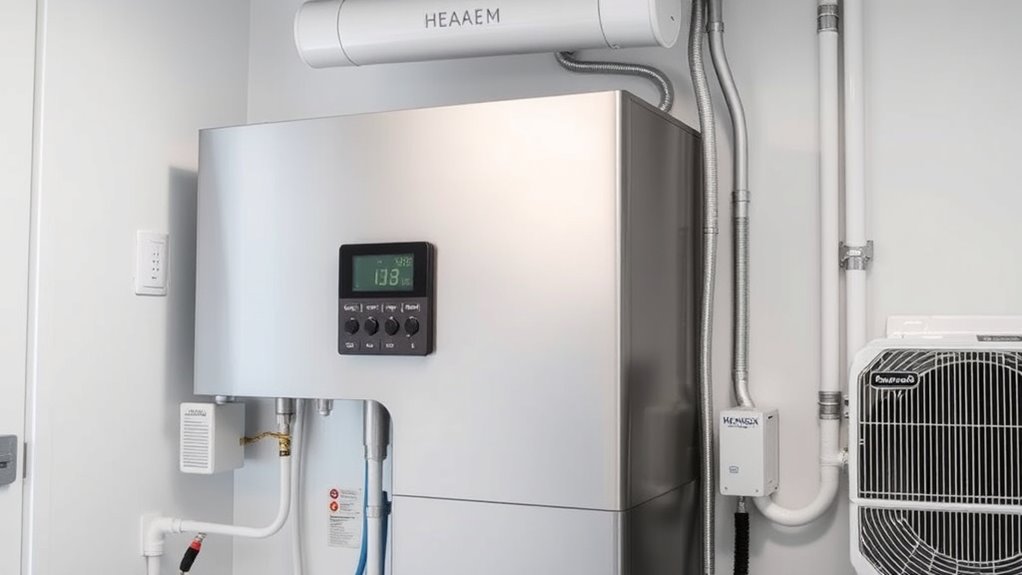
Adding humidity control components to your heat pump can substantially boost indoor comfort and efficiency. By maintaining ideal moisture levels—around 30-50%—you improve indoor air quality and prevent issues like mold and condensation. Dehumidifiers or humidifiers integrated with your system help regulate humidity, reducing the workload on your heat pump and increasing energy efficiency. Proper moisture management cuts down on energy use by up to 15%, as the system no longer has to work harder to control humidity fluctuations. Some advanced heat pump models come with built-in humidity sensors and variable-speed fans, automatically adjusting moisture levels for superior comfort. Upgrading with humidity control components is a smart system upgrade that enhances comfort, safeguards indoor air quality, and reduces your energy bills.
Upgrading to Cold-Climate Heat Pump Models

Upgrading to a cold-climate heat pump allows you to enjoy reliable, efficient heating even during the coldest winter days. These advanced models are specially designed to operate effectively at low temperatures, often down to -15°F, ensuring consistent comfort. Cold-climate heat pumps feature enhanced compressor technology, such as inverter-driven or variable-speed compressors, to maintain ideal performance in harsh conditions. Many are ENERGY STAR certified and meet strict efficiency standards like CEE Tier 3, maximizing energy savings. When you choose these upgrades, you’ll benefit from higher HSPF2 and SEER2 ratings, leading to better heating and cooling efficiency. This upgrade reduces reliance on fossil fuels, cuts energy costs, and lowers emissions, making it a smart choice for winter performance and overall efficiency.
Implementing Smart Thermostat Technologies

Implementing smart thermostat technologies can markedly boost your heat pump’s efficiency by optimizing temperature settings and reducing energy waste. Smart thermostats deliver precise temperature control and enable system optimization through customizable schedules and automatic adjustments based on occupancy, weather, and user preferences. This leads to significant energy savings—often up to 10-15% on heating and cooling costs. Many models integrate with home automation systems, allowing you to control your system remotely via smartphone apps and monitor real-time energy usage. Features like geofencing and adaptive learning help your heat pump operate only when needed, preventing unnecessary energy consumption. Upgrading to a smart thermostat is a cost-effective way to improve energy efficiency, extend system lifespan, and enhance overall comfort in your home.
Conducting Regular Maintenance and System Checks
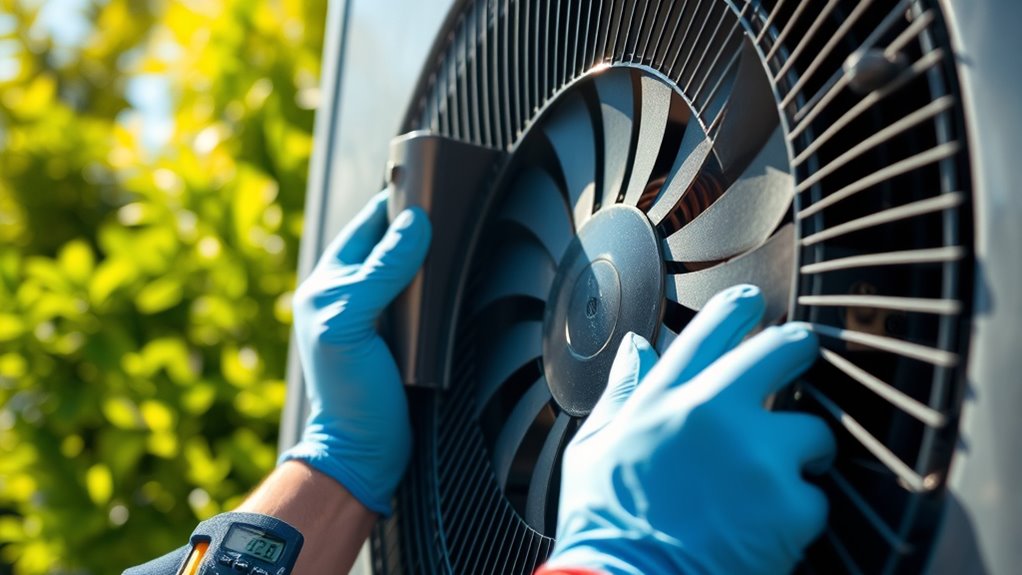
Regular maintenance is key to keeping your heat pump running efficiently. You should check and replace air filters every 1-3 months, inspect refrigerant levels annually, and schedule professional tune-ups. These simple steps help prevent issues and guarantee peak performance year-round.
Check Air Filter Regularly
Checking your air filter regularly is a simple but essential step to keep your heat pump running efficiently. When you replace or clean air filters every 1 to 3 months, you guarantee unobstructed airflow, which helps maintain top efficiency. A clean filter prevents dirt and debris from piling up inside the unit, supporting ideal heat transfer and reducing overheating risks. Dirty filters force the compressor and fan motor to work harder, increasing energy use and wear. Using filters with a MERV rating of 8 to 13 not only boosts efficiency but also improves indoor air quality. To maximize performance, consider:
- Regular filter replacement
- Inspecting filters for dirt buildup
- Choosing high-quality, efficient filters
Inspect Refrigerant Levels
Have you ever noticed reduced heating or cooling performance from your heat pump? Regularly inspecting refrigerant levels is crucial for maintaining system efficiency. Low or high refrigerant levels cause the compressor to work harder, increasing energy use and risking damage. Proper maintenance includes leak detection and ensuring refrigerant charges meet manufacturer specifications. When refrigerant levels are correct, your heat pump operates smoothly, preventing issues like frost buildup or insufficient heating and cooling. The Department of Energy recommends annual professional checks to keep refrigerant levels optimized, which helps your system meet efficiency standards like SEER2 and HSPF2. Staying on top of refrigerant maintenance ensures your heat pump runs efficiently, saving you money and extending its lifespan.
Schedule Professional Tune-Ups
Scheduling professional tune-ups is essential for keeping your heat pump running at peak efficiency. Regular maintenance ensures your system performs at its best and lasts longer. During a tune-up, a professional will inspect and clean key components, such as filters, refrigerant levels, and electrical connections. This helps prevent unexpected breakdowns and keeps your system running smoothly.
To deepen your system’s efficiency, a technician will:
- Inspect fans, compressors, and thermostats for proper operation
- Clean or replace filters to improve airflow and performance
- Check refrigerant levels and electrical connections for leaks or wear
Routine tune-ups can boost efficiency by up to 15%, reduce energy bills, and maintain high SEER2 and HSPF2 ratings. Regular professional inspections protect your investment and ensure reliable comfort year-round.
Frequently Asked Questions
How Can I Make My Heat Pump More Efficient?
To make your heat pump more efficient, start by sealing ductwork and insulating your home to prevent energy loss. Guarantee your system is properly sized and consider upgrading to a high-efficiency model with a SEER2 of 17+ and HSPF2 of 10.5+. Use a variable-speed blower for better humidity control and comfort, and schedule regular maintenance to keep everything running smoothly year-round.
How Often Should You Upgrade Your Heat Pump?
You should consider upgrading your heat pump every 10 to 15 years, depending on its age and performance. If your system’s efficiency ratings drop below regional standards or your energy bills spike, it’s time for an upgrade. Keep an eye on how well it handles winter and summer, and consult HVAC pros regularly. Early upgrades, especially for cold climate models, can help you save energy and stay comfortable.
What Is the Most Efficient COP for a Heat Pump?
Ever wonder how much your heat pump can truly save you? The most efficient models reach a COP of 4.5 or higher, meaning they produce 4.5 units of heat for every unit of electricity. Geothermal pumps often outperform air-source ones, hitting even higher COPs around 5.0. Aim for a system with a COP above 4.0, and you’ll maximize energy savings while staying warm and cozy all year round.
How Can a Heat Pump Be 200% Efficient?
You might wonder how a heat pump can reach 200% efficiency. It happens when the heat pump’s Coefficient of Performance (COP) hits 2.0, meaning it produces twice the heat energy compared to the electrical energy it consumes. This optimum efficiency occurs under ideal conditions or with advanced models, especially in moderate temperatures. Proper insulation, refrigerant choice, and system tuning help maximize performance, enabling the heat pump to operate near this efficiency level.
Conclusion
By embracing these upgrades, you turn your heat pump into a powerful symphony of efficiency, dance, and harmony. Each improvement acts like a brushstroke on a masterpiece, transforming your home into a cozy sanctuary that breathes easy and saves energy. With every tweak, you’re not just upgrading a system—you’re crafting a future where comfort and savings flow seamlessly, like a gentle stream, whispering promises of warmth and peace for years to come.
